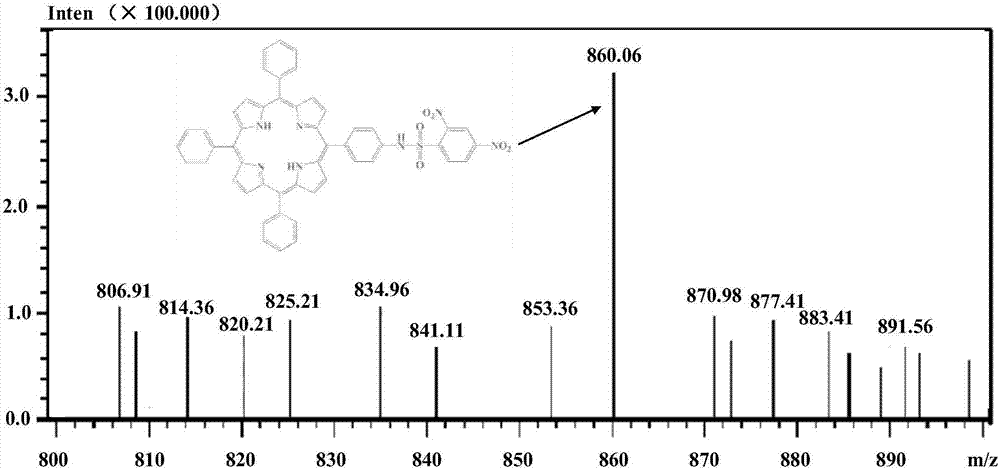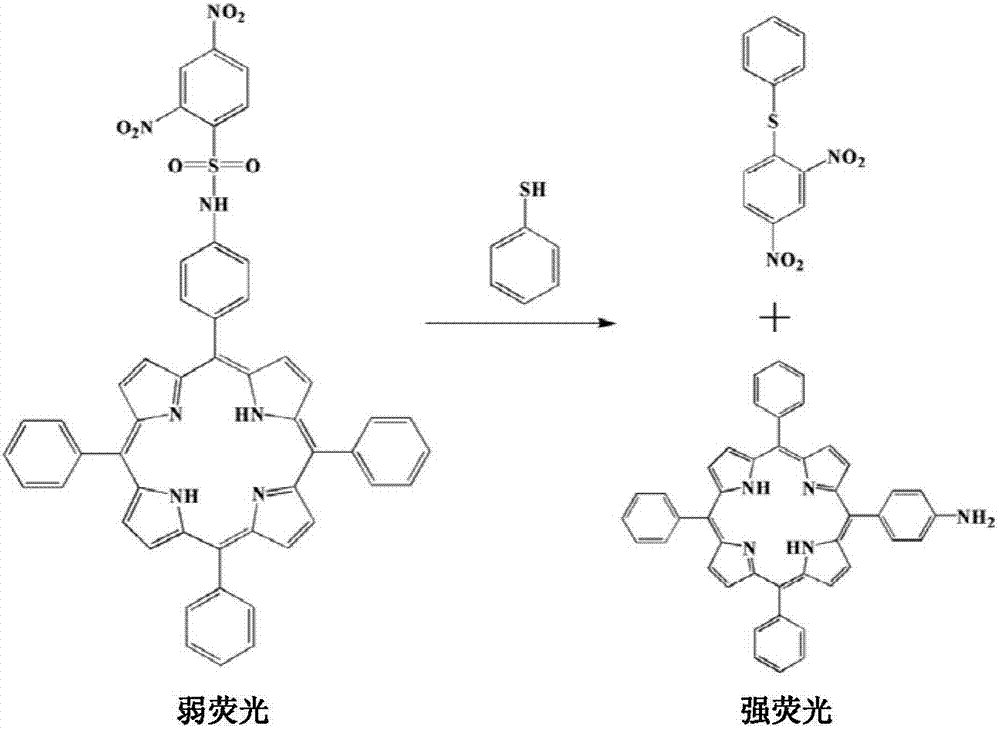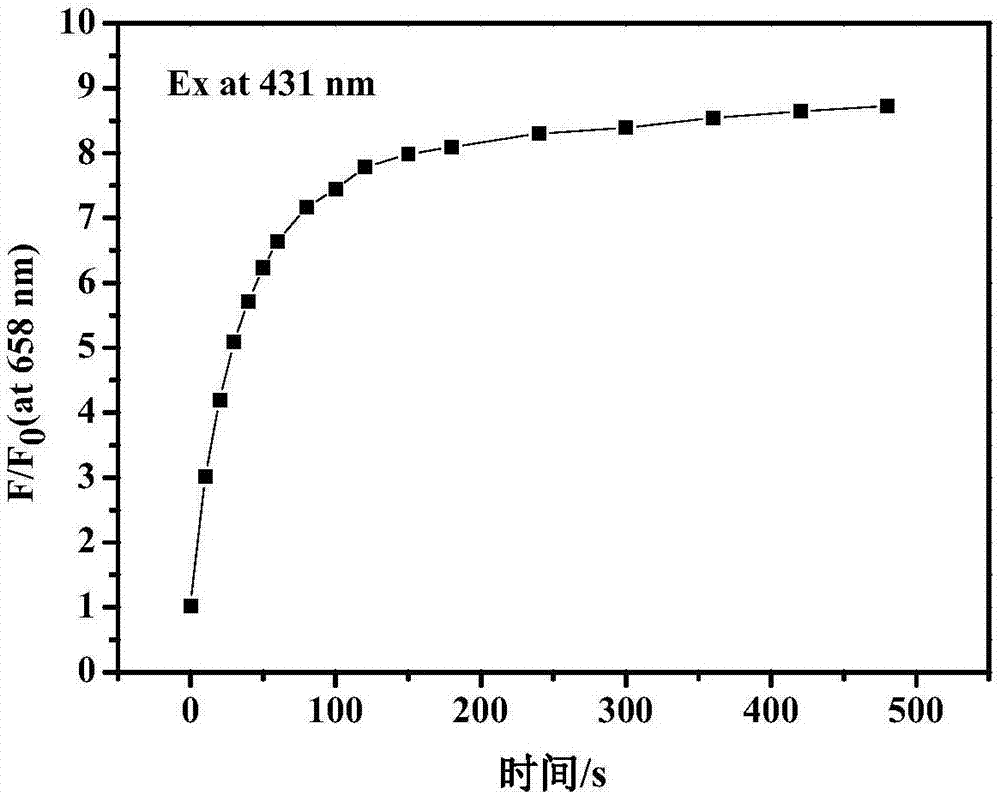Long wavelength type thiophenol fluorescent probe as well as preparation method and application thereof
A technology of fluorescent probes and thiophenols, applied in fluorescence/phosphorescence, chemical instruments and methods, luminescent materials, etc., can solve the problem of poor selectivity, difficulty in combining long-wave emission, high selectivity and fast response, slow response, etc. problem, achieve rapid identification and detection, high selectivity and anti-interference ability, and avoid interference
- Summary
- Abstract
- Description
- Claims
- Application Information
AI Technical Summary
Problems solved by technology
Method used
Image
Examples
Embodiment 1
[0032] A preparation method of a long-wave type thiophenol fluorescent probe, specifically comprising the following steps:
[0033] (1) Under ice cooling, add 172mg (0.2mmol) aminoporphyrin and 80mg (0.3mmol) 2,4-dinitrobenzenesulfonyl chloride to 15mL of anhydrous pyridine in turn, stir and dissolve, protect with nitrogen, and stir at room temperature The reaction was carried out for 6-8 hours, followed by TLC until the reaction was completed.
[0034] (2) Pour the above reaction solution into 150mL distilled water, filter, wash the filter cake with distilled water to obtain a purple solid; dissolve the purple solid in 20mL dichloromethane, wash with distilled water 3 times (20mL distilled water / time), and separate The organic layer was obtained, and the organic layer was dried over anhydrous sodium sulfate, the solvent was spin-dried under reduced pressure, purified by silica gel column chromatography, and dried in vacuum to obtain the target probe compound (TPP-DNBS).
Embodiment 2
[0036] A preparation method of a long-wave type thiophenol fluorescent probe, specifically comprising the following steps:
[0037] (1) Under ice cooling, add 0.3mmol aminoporphyrin and 0.4mmol 2,4-dinitrobenzenesulfonyl chloride to 20mL anhydrous pyridine successively, stir and dissolve, protect with nitrogen, stir at room temperature for 6~8h, TLC Follow up until the reaction is complete.
[0038] (2) Pour the above reaction solution into 200mL distilled water, filter, wash the filter cake with distilled water to obtain a purple solid; dissolve the purple solid in 25mL dichloromethane, wash twice with distilled water (20mL distilled water / time), and separate The organic layer was obtained, and the organic layer was dried over anhydrous sodium sulfate, the solvent was spin-dried under reduced pressure, purified by silica gel column chromatography, and dried in vacuum to obtain the target probe compound (TPP-DNBS).
Embodiment 3
[0040] A preparation method of a long-wave type thiophenol fluorescent probe, specifically comprising the following steps:
[0041] (1) Under ice cooling, add 0.3mmol aminoporphyrin and 0.5mmol 2,4-dinitrobenzenesulfonyl chloride to 30mL anhydrous pyridine in turn, stir and dissolve, protect with nitrogen, stir at room temperature for 6-8h, TLC Follow up until the reaction is complete.
[0042] (2) Pour the above reaction solution into 300mL distilled water, filter, wash the filter cake with distilled water to obtain a purple solid; dissolve the purple solid in 30mL dichloromethane, wash with distilled water 5 times (20mL distilled water / time), and separate The organic layer was obtained, and the organic layer was dried over anhydrous sodium sulfate, the solvent was spin-dried under reduced pressure, purified by silica gel column chromatography, and dried in vacuum to obtain the target probe compound (TPP-DNBS).
PUM
 Login to View More
Login to View More Abstract
Description
Claims
Application Information
 Login to View More
Login to View More - R&D
- Intellectual Property
- Life Sciences
- Materials
- Tech Scout
- Unparalleled Data Quality
- Higher Quality Content
- 60% Fewer Hallucinations
Browse by: Latest US Patents, China's latest patents, Technical Efficacy Thesaurus, Application Domain, Technology Topic, Popular Technical Reports.
© 2025 PatSnap. All rights reserved.Legal|Privacy policy|Modern Slavery Act Transparency Statement|Sitemap|About US| Contact US: help@patsnap.com



